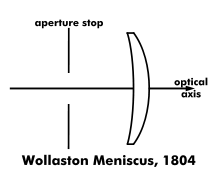Wollaston landscape lens

Wollaston Meniscus
The Wollaston landscape lens, named for William Hyde Wollaston, was a meniscus lens with a small aperture stop in front of the concave side of the lens, providing some improvement of aberrations. It was devised in 1812. It was the first reasonably sharp over a wide field (about 45° at f/11[1] and 50° at f/16) lens. Wollaston fitted it to an artist's aid camera obscura in 1812.[2]
This lens is still used in low-priced cameras. Besides its cheapness, the lens has the advantage of having only two glass-air surfaces.
References
- ↑ Handbook of photography, Whittlesey House, 1939, p.37.
- ↑ Kingslake 1989, pp. 23–26, 307.